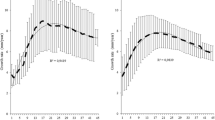Abstract
We studied the formation of heartwood in Erythrophleum fordii Oliv., an endangered rosewood species, by cross-section analysis on 52 stumps aged 28–57 years and arbitrarily sampled from natural forests in South China. Width and area of heartwood were positively correlated with age and xylem width (XW), and were independent of annual radial growth. The proportions of heartwood and sapwood areas were equal at about 40 years. The heartwood formation process was simulated by linear regression of age and XW.




Similar content being viewed by others
References
Cherubini P, Gartner BL, Tognetti R, Bräker OU, Schoch W, Inner JL (2003) Identification, measurement and interpretation of tree rings in woody species from mediterranean climates. Biol Rev 78:119–148
Copenheaver CA, Pokorski EA, Currie JE, Abrams MD (2006) Causation of false ring formation in Pinus banksiana: a comparison of age, canopy class, climate and growth rate. For Ecol Manag 236:348–355
Cordero LDP, Kanninen M (2003) Heartwood, sapwood and bark content, and wood dry density of young and mature teak (Tectona grandis) trees grown in Costa Rica. Silva Fenn 37:45–54
DeBell JD, Lachenbruch B (2009) Heartwood/sapwood variation of western red cedar as influenced by cultural treatments and position in tree. For Ecol Manag 258:2026–2032
Hein S, Spiecker H (2007) Comparative analysis of occluded branch characteristics for Fraxinus excelsior and Acer pseudoplatanus with natural and artificial pruning. Can J For Res 37:1414–1426
IUCN (2015) The IUCN Red list of threatened species. version 2015.1. www.iucnredlist.org. Downloaded on 11 June 2015
Knapic S, Pereira H (2005) Within-tree variation of heartwood and ring width in maritime pine (Pinus pinaster Ait.). For Ecol Manag 210:81–89
Langat DK, Kariuki JG (2004) Variations in heartwood proportion and basic density between provenances of Eucalyptus grandis in Kenya. J Trop For Sci 16:179–186
Miranda I, Gominho J, Lourenco A, Pereira H (2006) The influence of irrigation and fertilization on heartwood and sapwood contants in 18-year-old Eucalyptus globulus trees. Can J For Res 36:2675–2683
Miranda I, Gominho J, Lourenco A, Pereira H (2009) Variation of heartwood and sapwood in 18-year-old Eucalyptus globulus trees grown with different spacings. Trees 23:367–372
Morais MC, Pereira H (2007) Heartwood and sapwood variation in Eucalyptus globulus Labill. trees at the end of rotation for pulpwood production. Ann For Sci 64:665–671
Moya R, Berrocal A (2010) Wood colour variation in sapwood and heartwood of young trees of Tectona grandis and its relationship with plantation characteristics, site, and decay resistance. Ann For Sci 67:109
Nghia HN (2006) Forest genetic resources conservation and management in vietnam-an update on activities, challenges and needs since APFORGEN inception in,2003. In: Hong LT, Sim HC (eds) Forest genetic resources conservation and management. Dehradun, IPGRI-APO, pp 101–106
Niklas KJ (1997) Mechanical properties of Black Locust (Robinia pseudoacacia L.) wood. Size- and age-dependent variations in sap- and heartwood. Ann Bot 79:265–272
Pérez D, Kanninen M, Matamoros F, Fonseca W, Chaves E (2004) Heartwood, sapwood and bark contents of Bombacopsis quinata in Costa Rica. J Trop For Sci 16:318–327
Rugmini P, Jayaraman K (2009) Intrinsic units of growth for teak. Trees 23:51–58
Sellin A (1994) Sapwood and heartwood proportion related to tree diameter, age, and growth rate in Picea abies. Can J For Res 24:1022–1028
Spicer R (2005) Senescence in secondary xylem: heartwood formation as an active develop- mental program. In: Holbrook NM, Zwieniecki MJ (eds) Vascular transport in plants. Elsevier Academic Press, Amsterdam, pp 457–475
Stokes A, Berthier S (2000) Irregular heartwood formation in Pinus pinaster Ait. is related to eccentric, radial, stem growth. For Ecol Manage 135:115–121
Taylor AM, Gartner BL, Morrell JJ (2002) Heartwood formation and natural durability-a review. Wood Fiber Sci 34:587–611
Wang XC, Wang CK, Zhang QZ, Quan XK (2010) Heartwood and sapwood allometry of seven Chinese temperate tree species. Ann For Sci 67:410
Woeste KE (2002) Heartwood production in a 35-year-old black walnut progeny test. Can J For Res 32:177–181
Worbes M (1999) Annual growth rings, rainfall-dependent growth and long-term growth patterns of tropical trees from the Caparo Forest Reserve in Venezuela. J Ecol 87:391–403
Worbes M, Staschel R, Roloff A, Junk WJ (2003) Tree ring analysis reveals age structure, dynamics and wood production of a natural forest stand in Cameroon. For Ecol Manag 173:105–123
Yang KC, Hazenberg G (1991) Sapwood and heartwood width relationship to tree age in Pinus banksiana. Can J For Res 21:521–525
Zhao ZG, Guo JJ, Sha E, Lin KQ, Zeng J, Xu JM (2009) Geographic distribution and phenotypic variation of fruit and seed of Erythrophleum fordii in China. Chin Bull Bot 44:338–344
Acknowledgments
We are grateful to Mr. Er Sha and Ms. Kai-Qin Lin for their assistance in field sampling and disc measurement. We also thank Dr. Khongsak Pinyopusarerk of Black Mountain Laboratories of CSIRO Plant Industry, Australia for his editing of drafts of this manuscript.
Author information
Authors and Affiliations
Corresponding author
Additional information
Project fund: This work was financially supported by the Special Research Program for Public-welfare Forestry (No. 201204301-2) and National Nonprofit Institute Research Grant of RITF (No. RITFKYYW2010-05).
The online version is available at http://www.springerlink.com
Corresponding editor: Yu Lei
Rights and permissions
About this article
Cite this article
Zhao, Z., Guo, J., Wang, C. et al. Simulating the heartwood formation process of Erythrophleum fordii in South China. J. For. Res. 26, 1049–1055 (2015). https://doi.org/10.1007/s11676-015-0108-y
Received:
Accepted:
Published:
Issue Date:
DOI: https://doi.org/10.1007/s11676-015-0108-y




